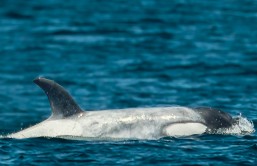A World War II-era I bronze bell was recently recovered from the wreck site of an imperial Japanese Navy mega-submarine I-400, which was intentionally sunk by U.S. forces in 1946 after its capture.
The discovery was led by veteran undersea explorer Terry Kerby, operations director and chief submarine pilot at the Hawai'i Undersea Research Laboratory (HURL). Measuring 400 feet in length, the I-400 was considered a "Sen-Toku" class submarine. Prior to the introduction of nuclear-powered subs in the 1960s, I-400 was the largest submarine ever built.
The massive aircraft-carrying submarine lies just off the southwest coast of the Hawaiian island of Oahu. The submarine was originally uncovered in 2013, sitting more than 2,300 feet below sea level. The wreck site is now protected under the Sunken Military Craft Act and managed by the Department of the Navy.
Using both of HURL's human-occupied submersibles, Pisces IV and Pisces V, researchers were able to bring the bronze bell to the surface. The recovery effort involved researchers from the University of Hawai'i School of Ocean and Earth Science and Technology, California State University-Chico (CSU-C), Naval History and Heritage Command and the USS Bowfin Submarine Museum.
"It was an exciting day for the submersible operations crews of Pisces IV and Pisces V. Just prior to our test dive, Dr. Georgia Fox [archaeologist at CSU-C] had received the underwater archaeological research permit from the Naval History and Heritage Command. We had only one chance to relocate and recover the bell," Kerby said.
At the end of World War II, the U.S. Navy captured five Japanese subs, including the I-400, and brought them to Pearl Harbor for inspection. However, when the Soviet Union demanded access to the submarines in 1946 under the terms of the treaty that ended the war, the U.S. Navy sank the subs off the coast of O'ahu to keep their advanced technology a secret. As of yet, HURL has only been able to locate four of these five lost submarines.
"These historic properties in the Hawaiian Islands recall the events and innovations of World War II, a period which greatly affected both Japan and the U.S. and re-shaped the Pacific region," explained Dr. Hans Van Tilburg, maritime heritage coordinator for the National Oceanic and Atmospheric Administration (NOAA) in the Pacific Islands region. "Wreck sites like the I-400 are reminders of a different time, and markers of our progress from animosity to reconciliation."
After a yearlong stabilization process, the bronze bell will be on display at the USS Bowfin Submarine Museum, where it will join binoculars and other artifacts recovered from the depths of the I-400 wreck site.
"The recovery of the bronze bell from the I-400, and its eventual display at the USS Bowfin Submarine Museum gives us a chance to share this history with more than three hundred thousand annual visitors, many from the Pacific Region. What was once an artifact on the seafloor will now be a national historic maritime treasure for all to see," added Jerry Hofwolt, executive director of the USS Bowfin Submarine Museum.
Watch archaeologists recover the bronze bell:








